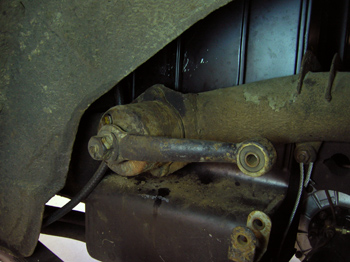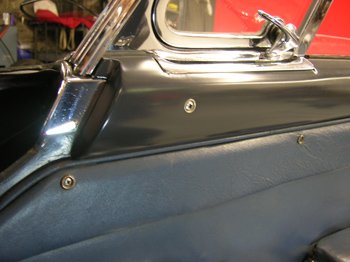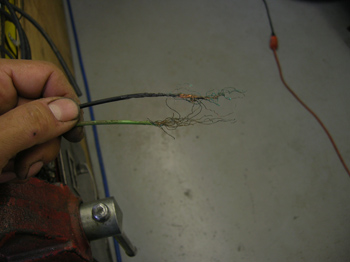PF Coupe 1747
9/23/10
PF Coupe 1747: Shocks and Headliner

I got to work on David E.’s PF Coupe, and the first order of business was to take a look at the shocks. Ever since we put the car on the road, there has been an annoying clicking noise from the rear end of the car. Considering we replaced all the rear bushings to the leaf springs last year, the noise was found coming from the shocks. After checking the oil level, we decided the shock had to come out and probably rebuilt.
This car uses lever arm Houdaille shocks, which are bolted to the frame rail. Unfortunately, they’re not coming out easily. The castle nuts are obscured, and a special tool may have to be made to get access. The only other way would be to remove the gas tank. Ugh!
Taking a break from under the car, I moved onto the next thing on our list which was to look at the headliner. The support rods sewn to the original headliner have come undone or rotted away, leaving the headliner hanging down from the ceiling of the car. It’s another annoyance we’re trying to resolve without completely replacing the original headliner. If you’ve been following this car for the past couple of years, you have seen how original this car is and how we’re trying our best to save the original materials and details.
I’m going to try my best to document all the details on this car, and see if we can determine what is original and what may have been replaced or modified over the years. My first question is do cars of this era have this shielded wire cover for the rear view mirror map light wiring?
I’ve always thought early cars have flat bladed screws securing much of the interior trim, and that is what I’ve found on many cars I’ve worked on, but there is an inordinate amount of Phillips screws on the interior panels of this car. Did someone replace these, or were they originally Phillips?
More Phillips head screws!
The trim washers are consistent with what is right for these cars. They have a slight rolled lip, but are much tinner than what I’ve found commercially available. I think someone was making reproductions of the original trim washers, and if you know who, e-mail me.
Like most Pininfarina built cars, most parts are stamped or marked with an assembly number. This car SN 1747’s PF number was 90 and is clearly stamped on the back of a windshield trim piece.
The #90 can also be seen marked on the back of the package shelf under the rear window. If we can preserve things like this, I feel we are paying homage to the people who made these cars over 50 years ago.
When you look at how this package shelf was constructed, you can see small shims placed under the backing board to bring the panel level under the rear window. Someone spent the time to get this perfectly level before covering it with vinyl. 
Under the package tray panel I found evidence of previous tenants. Sunflower seeds from a bird feeder made a nice meal and some good bedding material.
When I first started working on 1747, I found the remains of one of the tenants in this car, and maybe the nest under the rear window belonged to a relative!
After a good vacuuming all signs of wildlife and the threat of hantavirus was removed!
More evidence of rodent damage was found on some wiring. David asked me to check why the dome light wasn’t working, and as I pulled the wiring out of the ceiling, I found it wasn’t connected. The frayed ends showed signs of chewing, and the corrosion on the copper showed the bare wires shorted out when the battery was plugged in. When the headliner comes out, we’ll wire this harness back in.
Reminder: If you’re looking for a Vintage Ferrari, or have a Vintage Ferrari for sale, please let me know. I would be happy to help you in any way that I can. I am not a broker, but occasionally hear of a good car for sale and can get them to the end user!
Previous Restoration Day
Next Restoration Day
Home page




